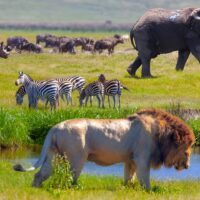White-tailed deer can live up to 6-14 years in the wild. Captive deer may live longer, up to 20 years.
White-tailed deer are one of the most common deer species in North America. They are known for their agility and adaptability. Understanding their life cycle is important for wildlife enthusiasts and conservationists. White-tailed deer face various challenges that affect their lifespan, including predators and environmental factors.
Their life stages include fawn, yearling, and adult. Each stage has unique characteristics and survival strategies. This comprehensive guide explores the life expectancy and different phases of white-tailed deer. It also highlights factors influencing their longevity. By learning about their life cycle, we can better appreciate and protect these magnificent animals.
Introduction To White-tailed Deer
The White-Tailed Deer is a fascinating and graceful creature. Known for its distinctive tail, this deer is widespread in North America. It plays a vital role in the ecosystem. Understanding its life cycle helps appreciate its importance.
Species Overview
The White-Tailed Deer, scientifically named Odocoileus virginianus, belongs to the family Cervidae. It is recognized by its reddish-brown coat in summer and grayish-brown in winter. The white underside of its tail is a key feature. Male deer, called bucks, grow antlers every year. Female deer, known as does, do not have antlers.
White-Tailed Deer are herbivores, consuming a variety of plants. Their diet includes leaves, twigs, fruits, and nuts. They are known to adapt their eating habits based on the season.
Habitat And Range
White-Tailed Deer are highly adaptable to different environments. They thrive in forests, fields, and even suburban areas. Their range extends from southern Canada to South America. They are most commonly found in the United States.
These deer prefer areas with dense foliage. It provides them with food and cover from predators. They are also found near water sources like rivers and lakes. This ensures they have access to drinking water.
White-Tailed Deer are primarily crepuscular. This means they are most active during dawn and dusk. Their keen senses of smell and hearing help them detect danger. They communicate through various sounds and body language.
bold keywords helps in emphasizing important terms, and short sentences ensure readability.
Life Expectancy In The Wild
The life expectancy of a white-tailed deer in the wild varies. Factors like habitat, predators, and disease influence their lifespan. This section explores their average lifespan and the factors affecting their longevity.
Average Lifespan
White-tailed deer typically live between 4 to 5 years in the wild. Some deer can live up to 10 years, but this is rare. Most deer do not reach old age due to various challenges.
| Age | Percentage of Population |
|---|---|
| 1 year | 40% |
| 2-3 years | 30% |
| 4-5 years | 20% |
| 6-10 years | 10% |
Factors Affecting Longevity
- Predators: Wolves, coyotes, and humans are common predators.
- Habitat: Quality of food and shelter impacts deer lifespan.
- Diseases: Chronic wasting disease and other illnesses shorten life.
- Weather: Harsh winters can reduce survival rates.
Predators are a significant threat to young deer. Many fawns do not survive their first year. Good habitat provides food and protection. Poor habitat leads to malnutrition and vulnerability. Diseases like chronic wasting disease spread quickly among deer. This disease is fatal and reduces their lifespan. Harsh weather, especially in winter, affects food availability. Cold temperatures and deep snow make it hard for deer to find food.
Life Stages Of White-tailed Deer
The life cycle of a white-tailed deer is a journey through distinct stages. Each stage brings unique challenges and milestones. Understanding these stages helps us appreciate these magnificent creatures.
Fawn Stage
The fawn stage is the beginning of a white-tailed deer’s life. Fawns are born in late spring or early summer. They weigh around 6 to 8 pounds at birth.
Fawns have white spots on their brown fur. These spots help them blend into the environment. This camouflage protects them from predators.
During the first few weeks, fawns stay hidden in tall grass. Their mothers visit them several times a day to nurse them. Fawns can walk within hours of birth but remain dependent on their mothers for several months.
Juvenile Stage
The juvenile stage begins when the fawn is about 6 months old. At this stage, the spots start to disappear. Juveniles grow rapidly and learn to forage for food.
Juveniles stay with their mothers through their first winter. They learn survival skills and social behaviors. By the spring, they are more independent.
During this stage, young bucks begin to grow their first set of antlers. These antlers are usually small and called “spikes.”
Adult Stage
The adult stage starts when the deer is around 1.5 years old. Adult white-tailed deer are fully grown and sexually mature.
Bucks grow larger antlers each year. The size of the antlers depends on nutrition and genetics. Does, on the other hand, reach peak fertility and can give birth to one to three fawns each year.
Adult deer establish home ranges and social hierarchies. They are more adept at avoiding predators. This stage continues until the deer reaches the end of its lifespan, which can be up to 10 years in the wild.
Survival Challenges
White-tailed deer face numerous survival challenges throughout their lives. Understanding these challenges is crucial for appreciating their life cycle. Here, we explore the main threats to their survival.
Predators
White-tailed deer have several natural predators. Coyotes, bobcats, and mountain lions are the primary threats. Young fawns are especially vulnerable. They often fall prey to these predators.
Wolves and bears also hunt deer. Predation rates can vary based on region and predator populations.
Diseases
Diseases pose a significant risk to white-tailed deer. Chronic Wasting Disease (CWD) is a major concern. It affects the deer’s brain and nervous system. Infected deer often die within months.
Epizootic Hemorrhagic Disease (EHD) is another threat. It spreads through biting midges. Infected deer can die within days. Both diseases impact deer populations severely.
Human Impact
Human activities greatly affect white-tailed deer. Habitat destruction is a major issue. Urban development reduces their natural habitats. This forces deer into smaller, fragmented areas.
Hunting also impacts deer populations. Regulated hunting can manage deer numbers. However, overhunting can reduce local populations drastically.
Vehicle collisions are another human-related threat. Many deer die annually due to car accidents. This is especially common in areas with high deer populations.
| Survival Challenge | Details |
|---|---|
| Predators | Coyotes, bobcats, mountain lions, wolves, and bears |
| Diseases | Chronic Wasting Disease, Epizootic Hemorrhagic Disease |
| Human Impact | Habitat destruction, hunting, vehicle collisions |
Role Of Nutrition
The nutrition of a white-tailed deer plays a vital role in its life cycle. Proper nutrition impacts their health, growth, and longevity. Understanding their diet in different seasons helps us ensure they get the nutrients they need.
Diet In Different Seasons
White-tailed deer have varied diets based on the season. They eat what’s available in their habitat.
| Season | Primary Food Sources |
|---|---|
| Spring | Fresh green plants, buds, and shoots |
| Summer | Grasses, leaves, and fruits |
| Fall | Acorns, nuts, and fallen fruits |
| Winter | Woody browse, twigs, and bark |
Impact On Health
A deer’s health depends on its diet. Good nutrition leads to strong antlers, healthy fawns, and a longer life.
- Protein: Necessary for growth and muscle development.
- Carbohydrates: Provide energy, especially in winter.
- Fats: Essential for storing energy and insulation.
- Vitamins and Minerals: Support overall health and bodily functions.
Deer with poor nutrition are more prone to diseases. They may also have shorter lifespans. Ensuring they have access to diverse food sources is key.
Conservation Efforts
Conservation efforts play a crucial role in ensuring the survival of white-tailed deer. These efforts focus on maintaining and enhancing their natural habitats, managing population levels, and protecting them from threats. Below, we explore the key aspects of conservation: habitat preservation and population management.
Habitat Preservation
Habitat preservation is essential for the survival of white-tailed deer. Healthy habitats provide food, water, and shelter. Forests, grasslands, and wetlands are vital habitats for these deer.
Organizations work to protect these areas from deforestation and urban sprawl. They also restore damaged habitats to support deer populations. Planting native vegetation helps ensure deer have adequate food sources.
Creating wildlife corridors connects fragmented habitats. This allows deer to move safely between areas. Protected areas, like national parks, offer safe havens for deer.
Population Management
Population management helps maintain a healthy balance of deer in the wild. Overpopulation can lead to food shortages and increased disease spread.
Wildlife agencies use various techniques for population control. These include regulated hunting and relocation programs.
Regulated hunting helps control deer numbers without harming the ecosystem. Hunters must follow strict rules to ensure sustainable practices.
Relocation programs move deer from overpopulated areas to regions with fewer deer. This helps prevent habitat degradation and promotes genetic diversity.
Monitoring programs track deer health and population trends. Data collected helps refine conservation strategies and ensure effective management.
Frequently Asked Questions
What Is The Maximum Lifespan Of A White-tailed Deer?
The maximum lifespan of a white-tailed deer is around 20 years. In the wild, they typically live 4-5 years.
What Is A White-tailed Deer’s Life Cycle?
A white-tailed deer’s life cycle includes four stages: birth, fawn, adult, and senior. They live up to 10 years.
Why Do Whitetail Deer Have Such A Short Lifespan?
Whitetail deer have a short lifespan due to predation, disease, hunting, and harsh environmental conditions. These factors significantly reduce their longevity.
How Old Is The Oldest Deer?
The oldest known deer lived up to 23 years. This lifespan is exceptional, as most deer live 10-15 years in the wild.
How Long Do White-tailed Deer Live?
White-tailed deer can live up to 6-14 years in the wild.
Conclusion
Understanding the lifespan of white-tailed deer helps in wildlife conservation. These deer can live up to 20 years. Factors like habitat, diet, and predators influence their longevity. Protecting their environment ensures healthier and longer lives. By learning more, we contribute to their survival and thriving ecosystems.








